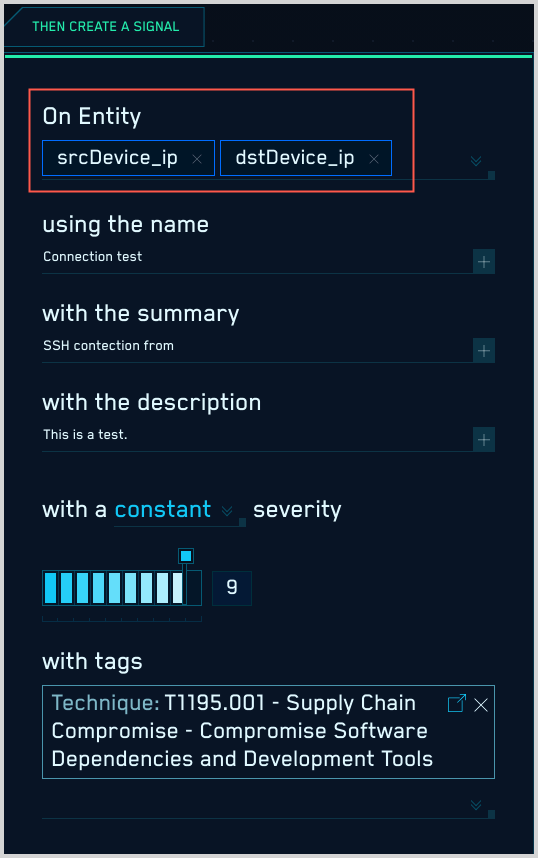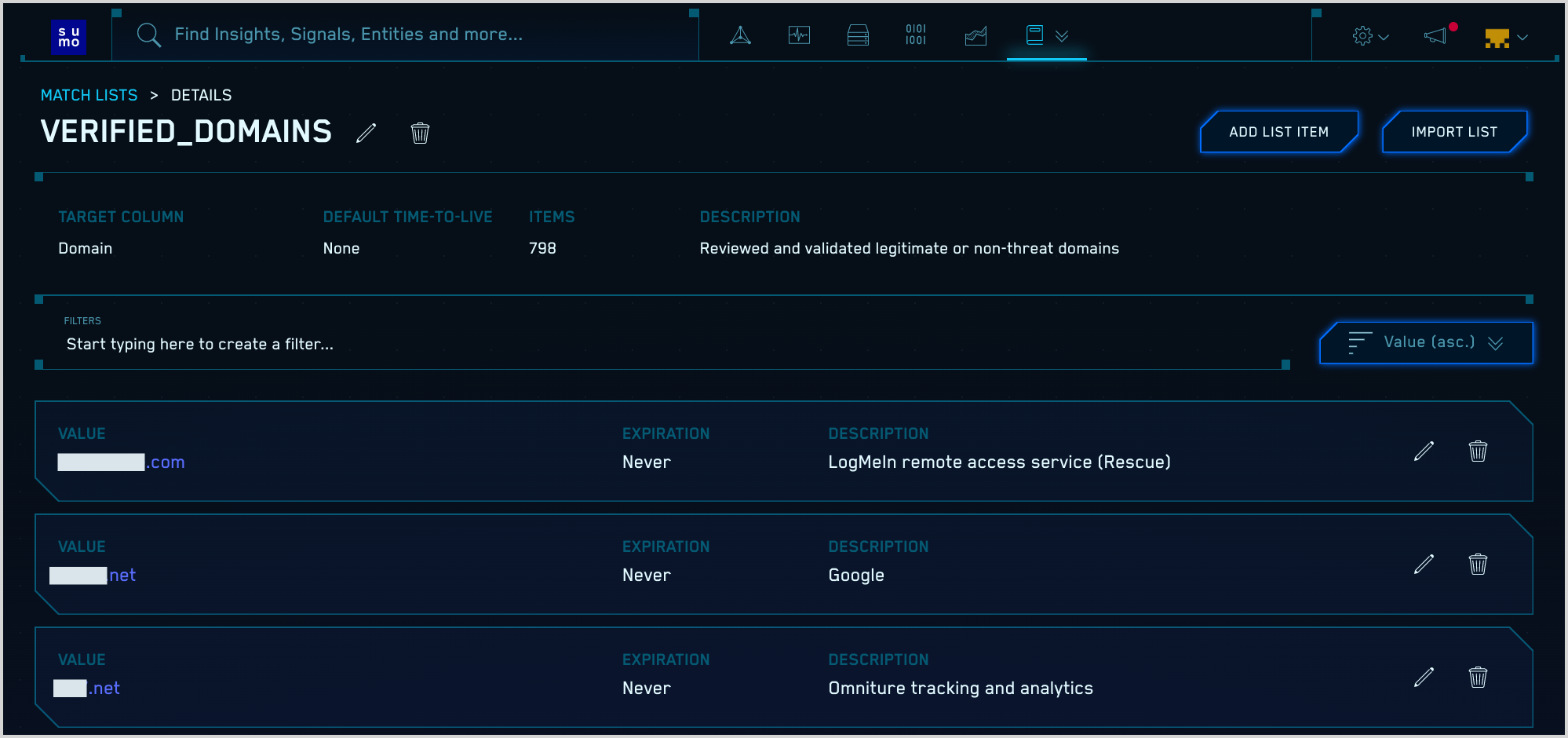About CSE Rules
A CSE rule is logic that fires based on information in incoming Records. When a rule fires, it creates a Signal.
About rule expressions
The key element of a CSE rule is a rule expression. A rule expression defines what conditions the rule will look for. A rule expression includes one or more equality statements, each of which evaluates a field value in incoming Records, typically comparing it to a constant value, for example description = 'CMS Domain Match'. A simple rule expression might be a single equality expression, or multiple expressions combined with logical operators. A rule expression evaluates to a boolean value. When a rule’s conditions are met, it creates a Signal.
The following rule expression, which looks for any event that stops AWS CloudTrail logging, is an example of a rule expression that contains only equality statements.
metadata_vendor = 'AWS' and metadata_product = 'CloudTrail' and fields.eventName = "DeleteTrail" or fields.eventName = "StopLogging" or fields.eventName = "UpdateTrail"
Rule expressions can also use regular expressions and CSE rules language functions, which include SQL-like and domain-specific functions. For more information see CSE Rules Syntax.
note
The Before You Write a Custom Rule topic has useful information about how to prototype a rule expression in CIP.
About tuning expressions
Like a rule expression, a tuning expression is matched against incoming Records. The difference is, if a Record matches a Rule’s tuning expression in addition to its rule expression, the rule will not generate a Signal.
As an example, consider the following rule expression, which detects that an attempt was made to clear the Windows Security Event Log.
metadata_vendor = 'Microsoft' and metadata_product = 'Windows' and metadata_deviceEventId = 'Security-1102' and fields['Provider.Name'] = 'Microsoft-Windows-Eventlog'
If you don’t want the rule to generate a Signal if the person performing the action is “jdoe”, you can add a tuning expression like this to the rule:
user_userId = !jdoe
The tuning expression is AND’d with the rule expression—the rule will only generate a Signal if a Record matches both expressions.
Rule tuning expressions allow you to tailor the logic of a built-in rule without logic without replicating and modifying the rule. The benefit of using a tuning expression, over the copy and edit method, is that when CSE updates built-in rules, your tuning expressions are preserved. This division of logic means that you don’t need to create as many custom rules. If you use tuning expressions in combination with multi-entity rules you’ll further reduce the need for custom rules.
You create tuning expressions on the Rule Tuning page, which is available from the Content menu. When you create a tuning expression, you have the option of applying to all of your rules, or to selected rules. Or, you can apply tuning expressions when you create a rule. You can apply multiple tuning expressions to a rule. You can assign a tuning expression to selected rules, or to all of your rules. You can also create a tuning expression without immediately assigning it to any rules. For more information, see Rule Tuning Expressions.
"On Entity" configuration
In CSE, the term Entity refers to an IP address, hostname, username, or MAC address. When you create a CSE rule, you select one or more On Entity attributes in the Then Create a Signal part of the UI. An On Entity attribute is a CSE schema attribute that hold an IP address, hostname, username, or MAC address.
The screenshot below shows a rule whose "On Entity" attributes are srcDevice_ip and dstDevice_ip.

When an incoming Record meets a rule's conditions, a Signal is generated for each of the rule's On Entity attributes found in the Record. When the example rule above fires, it generates two Signals: one on the IP address one held in the srcDevice_ip attribute, and another on the IP address held in the dstDevice_ip attribute.
Rule types
There are four kinds of rules. Each supports a different sort of firing behavior.
- Match rule. Fires when an incoming Record matches the rule expression. A Match rule is stateless: it looks at a single Record, and it either fires or it doesn’t. The expression in the previous section is an example of a Match rule expression. If a Record matches the expression, the rule fires. For more information about Match rules, see Write a Match Rule.
- Threshold rule. Fires when the rule expression is matched at least a certain number times during a specified length of time. For example, if there are five or more failed login attempts for the same IP address within one hour. A Threshold rule is stateful, a condition must be satisfied by multiple Records over a period of time. For more information about Threshold rules, see Write a Threshold Rule.
- Chain rule. You can use a Chain rule to look for two or more types of events, and to fire, based on the frequency of each over a time window. For example, when a user has more than 10 failed login attempts and one successful login attempt in a one hour window. Like a Threshold rule, a Chain rule is stateful and counts multiple Records—the difference is that a Chain rule applies multiple expressions to a Record. For more information about Chain rules, see Write a Chain Rule.
- Aggregation rule. Fires when up to three aggregation conditions are met within a specified period of time. For example, when a large variety of different AWS CloudTrail event IDs from the same
device_ipare observed within a 30 minute period. For more information about Aggregation rules, see Write an Aggregation Rule.
Product identification metadata fields
During the Record parsing process, CSE adds metadata that identifies the product or service that generated the Record. You use this metadata in a rule to specify what Records the rule should be applied to. For example, the rule fragment below will match Records generated by Trend Micro Deep Security devices with IDs in a specified range:
metadata_vendor = 'Trend Micro' and metadata_product = 'Deep Security' and metadata_deviceEventId between '2000000' and '2999999'
Some of the key metadata fields are defined below.
| Metadata field | Type |
|---|---|
metadata_vendor | string |
metadata_product | string |
metadata_deviceEventId | string |
Rules and other content
This section describes two key CSE features that enable you to write richer rules that can look up information about the entities that are actors in a Record. For example, you could compare a domain in a Record to a list of allowed listed domains. Or you could compare an IP address to a list of IP addresses known to be indicators of compromise.
Match Lists
The subsections below explain how Match Lists work, and how to leverage them in CSE rules.
Match Lists are used to enrich Record data
This section describes what Match Lists are, and how CSE uses them to enrich Record data. The short story is that when a Record is ingested, CSE uses Match Lists to add information to the Record. So, your rule doesn’t directly refer to a Match List, it checks the Record for data that CSE may have added to the Record at the time of ingestion.
Match Lists are lists of important indicators and identifiers, typically configured by a CSE analyst. Match Lists are often used to define allowlists of entities, like IP addresses, URLs, and hostnames, and so on, that you want to exempt from ordinary rule processing. For example, you might want to prevent a rule from firing for Records that contain one of a certain set of IP addresses.
Here’s an example of a Match List in the CSE UI, at Content > Match Lists.

You can take advantage of Match Lists in rules, but Match Lists actually come into play when Records are ingested. Here’s how it works: When a Record is ingested, CSE compares the entries in all Match Lists to fields in the Record. Of course, CSE doesn’t compare the entries in a given Match List to all fields in a Record; it wouldn’t make sense to compare a domain name to an IP address. You could say that CSE understands the difference between apples and oranges: CSE distinguishes which Record fields contain IP addresses, which contain domain name and so on. So, CSE compares a Match List of IP addresses to Record fields that contain IP addresses. Similarly, CSEs compares a Match List of usernames to Record fields that contain usernames. For more information about how that works, see Match Fields Reference.
When a Record contains a value that matches one or more Match Lists, two fields in the Record get populated:
listMatches.CSE adds the names of the Match Lists that the Record matched, and the column values of those lists. For example, if an IP address in a Record matches theSourceIPaddress in the “vuln_scanners” Match List, thelistMatchesfield would look like this:listMatches: ['vuln_scanners', 'column:SourceIp']matchedItems. CSE adds the actual key-value pairs that were matched. For example, continuing the example above, if “vuln_scanners” Match List contained an entry “5.6.7.8”, and the Record’sSourceIpis also “5.6.7.8”, the assuming theSourceIPaddress in the “vuln_scanners” Match List, thematchedItemsfield would like like this:matchedItems: [ { value: '5.6.7.8', …other metadata about list item } ]
Because the information about list matches gets persisted within Records, you can reference it downstream in both rules and search.
Rules look for match data in Records
When you’re writing a rule that needs to take advantage of the results of the list matching process described above, you extend your rule expression with the array_contains function.
The syntax is:
array_contains(listMatches, "match-list-name")
where
match-list-nameis the name of the match list.:::note If the name of the list you are referencing with
array_containscontains any spaces, replace the spaces with underscores. For example, if the list name is my list, refer to it as my_list. :::
Depending on your goal, you precede the array_contains function with either AND or AND NOT.
For example, the fragment below looks at a Record for a field named listMatches that contains the value “vuln_scanners”. If not encountered, that indicates that the IP address is not a vulnerable scanner, so, given that the rest of the rule expression is matched, a Signal will be fired for that Record.
... AND NOT array_contains(listMatches, "vuln_scanners")
This example below checks a Record for a field named listMatches that contains either “vul_scanners” or “business_ips”. Notice that the two array_contains statements are combined with an OR and enclosed in parentheses:
...AND NOT (array_contains(listMatches, 'vuln_scanners') OR array_contains(listMatches, 'business_ips'))
Threat Intel
CSE’s Threat Intel lists are very similar to Match Lists, and you leverage them in rules in the same way. Threat Intel lists contain values that, when encountered in a Record, are clear indicators of compromise.
Here’s an example of a Threat Intel list in the CSE UI, at Content > Threat Intel.

Like Match Lists, Threat Intel lists are used at the time of Record ingestion. When a Record is ingested, CSE determines whether any of the fields in the Record exist in any of your configured Threat Intel lists.
When a Record contains a value that matches an entry in one or more Threat Intel lists, just like with Match List data, two fields in the Record get populated: a listMatches field that contains the names of Threat Intel lists that the Record matched, and a matchedItems field that contains the actual key-value pairs that were matched. In addition, the string “threat” is added to the listMatches field.
For example, given a Record whose SourceIp column matches a entry in My Threat Intel List, the listMatches field added to the record would look like this:
listMatches: ['My Threat Intel List', 'column:SourceIp', 'threat']
Because the threat intel information is persisted within Records, you can reference it downstream in both rules and search. To leverage the information in a rule, you extend your rule expression with the array_contains function. The syntax is:
array_contains(listMatches, "threat-intel-list-name")
where
threat-intel-list is the name of the Threat Intel list.